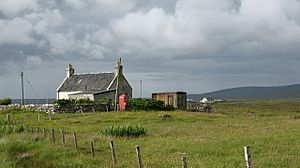Baleshare facts for kids
| Gaelic name | Am Baile Sear |
|---|---|
| Meaning of name | Gaelic for 'east town'. |
| OS grid reference | NF788619 |
| Coordinates | 57°32′N 7°22′W / 57.53°N 7.37°W |
| Physical geography | |
| Island group | Uists and Barra |
| Area | 910 hectares (3.5 sq mi) |
| Area rank | 54 |
| Highest elevation | 12 metres (39 ft) |
| Administration | |
| Sovereign state | United Kingdom |
| Country | Scotland |
| Council area | Na h-Eileanan Siar |
| Demographics | |
| Population | 58 |
| Population density | 6.4 people/km2 |
| Largest settlement | Samhla |
Baleshare (which means Baile Sear in Scottish Gaelic) is a flat island in the Outer Hebrides of Scotland. It's a special type of island called a tidal island, which means it can sometimes be reached by land at low tide.
Baleshare is located southwest of North Uist. Life on the island became much easier when a causeway was built in 1962. This causeway, about 350 metres (380 yards) long, connects Baleshare to North Uist. The island is very flat, especially for the Hebrides, rising only 12 metres (39 feet) above sea level. It is also famous for its long, sandy beach. About 49 people live here in two small villages called Samhla and Teananachar.
What's in a Name?
The name Baleshare means 'east farm' or 'east town' in Gaelic. People believe there might have been a 'west town' on land that has since disappeared into the sea. This lost land was said to be west of Baleshare and might have connected to the Monach Islands at low tide. The Monach Islands are about 15 kilometres (9.3 miles) to the west.
Another old story suggests there was once a land bridge to Kirkibost, which is about 100 metres (330 feet) north of Baleshare. This idea comes from old records from 1542. These records mention that the value of the land had gone down because the sea had taken over some areas.
Archaeologists have found two very old settlements on Baleshare. These sites show signs of people living there long ago. They have uncovered:
- The remains of a round stone house.
- Pieces of pottery.
- Old bones.
- Bits of metal.
Just like many other ancient sites in this area, these settlements are in danger from coastal erosion. This means the sea is slowly wearing away the land where these important historical clues are found.
See also
 In Spanish: Baleshare para niños
In Spanish: Baleshare para niños


